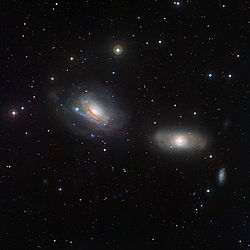- Interacting galaxy
-
 NGC 3169 (left) and NGC 3166 (right) display some curious features, demonstrating that each member of the duo is close enough to feel the distorting gravitational influence of the other. Iimage from the Wide Field Imager on the MPG/ESO 2.2-metre telescope at the La Silla Observatory.
NGC 3169 (left) and NGC 3166 (right) display some curious features, demonstrating that each member of the duo is close enough to feel the distorting gravitational influence of the other. Iimage from the Wide Field Imager on the MPG/ESO 2.2-metre telescope at the La Silla Observatory.
Interacting galaxies (Colliding galaxies) are galaxies whose gravitational fields result in a disturbance of one another. An example of a minor interaction is a satellite galaxy's disturbing the primary galaxy's spiral arms. An example of a major interaction is a galactic collision.
Contents
Satellite interaction
A giant galaxy interacting with its satellites is common. A satellite's gravity could attract one of the primary's spiral arms. Or the satellite could dive in to the primary (e.g. Sagittarius Dwarf Elliptical Galaxy). This could trigger a small amount of star formation.
Galaxy collision
Colliding galaxies are common in galaxy evolution. Due to the extremely tenuous distribution of matter in galaxies, these are not collisions in the normal sense of the word, but rather gravitational interaction. Colliding may lead to merging. This occurs when two galaxies collide and do not have enough momentum to continue traveling after the collision. Instead, they fall back into each other and eventually merge after many passes through each other, forming one galaxy. If one of the colliding galaxies is much larger than the other, it will remain largely intact after the merger; that is, the larger galaxy will look much the same while the smaller galaxy will be stripped apart and become part of the larger galaxy. Through-passes are less disruptive of galaxy shapes than mergers in that both galaxies largely retain their material and shape after the pass.
Galaxy collisions are now frequently simulated on computers, with all the realistic physics, including gravity forces, gas dissipation, star formation and feedback. Dynamical friction slows down galaxy pairs, which may or may not merge at some point, according to the initial relative energy of the orbits. A simulated library of galaxy collisions can be found at the Paris Observatory website: GALMER [1]
-
The Whirlpool Galaxy with its satellite NGC 5195.
-
The Mice Galaxies.
-
This simulation follows the collision of two spiral galaxies that harbour giant black holes.
Galactic cannibalism
Galactic cannibalism refers to the process by which a large galaxy, through tidal gravitational interactions with a companion, merges with that companion, resulting in a larger, often irregular galaxy.
The most common result of the gravitational merger of two or more galaxies is an irregular galaxy of one form or another, although elliptical galaxies may also result.
It has been suggested that galactic cannibalism is currently occurring between the Milky Way and the Large and Small Magellanic Clouds. Streams of gravitationally-attracted hydrogen arcing from these dwarf galaxies to the Milky Way is taken as evidence for this theory.
Notable interacting galaxies
Name Type Distance
(million ly)Magnitude Notes Whirlpool Galaxy (M51) SAc (SB0-a) 37 +8.4 Satellite interacting with its primary NGC 2207 and IC 2163 SAc/SAbc 114 +11 galaxies going through the first phase in galactic collision Mice Galaxies (IC 819/20) S0/SB(s)ab 300 +13.5 galaxies going through the second phase in galactic collision NGC 1097 SB(s)bc (E6) 45 +9.5 Satellite interacting with its primary Antennae Galaxies (NGC 4038/9) SAc/SBm 45 +10.3 galaxies going through the third phase in galactic collision NGC 520 S 100 +11.3 galaxies going through the third phase in galactic collision Future collision of the Milky Way with Andromeda
Astronomers have estimated that our galaxy, the Milky Way galaxy, will collide with the Andromeda galaxy in about 4.5 billion years. It is thought that the two spiral galaxies will merge to become an elliptical galaxy.[2][3]
See also
Galaxy Morphology - Elliptical galaxy
- Lenticular galaxy
- (unbarred
- barred)
- Spiral galaxy
- ([barred
- intermediate
- unbarred]
- [grand design
- flocculent
- Magellanic spiral])
- Irregular galaxy
- Dwarf galaxy
- Dwarf elliptical
- Dwarf spheroidal
- Dwarf spiral)
- Giant galaxy
- (Giant elliptical
- D-galaxy
- cD-galaxy)
Structure Active nuclei Energetic galaxies - Starburst galaxy
- (Wolf–Rayet
- BCD
- pea)
- LIRG
- (ULIRG
- HLIRG)
- LAE
Interaction - Stellar stream
- Interacting galaxy
- Satellite galaxy
- Groups and clusters
- (fossil group
- brightest cluster galaxy)
- Superclusters
- Walls
- Field galaxy
- Void galaxy
- Voids and supervoids
Lists See also - Dark galaxy
- Intergalactic dust
- Intergalactic travel
- Intergalactic stars
 Book:Galaxies
Book:Galaxies Category:Galaxies
Category:Galaxies Portal:Astronomy
Portal:Astronomy
References
- ^ GALMER 27 March 2010
- ^ Hazel Muir, "Galactic merger to 'evict' Sun and Earth," New Scientist 4 May 2007
- ^ Astronomy, June 2008, page 28, by Abraham Loeb and T.J.Cox
External links
Categories:- Interacting galaxies
- Extragalactic astronomy
-
Wikimedia Foundation. 2010.


